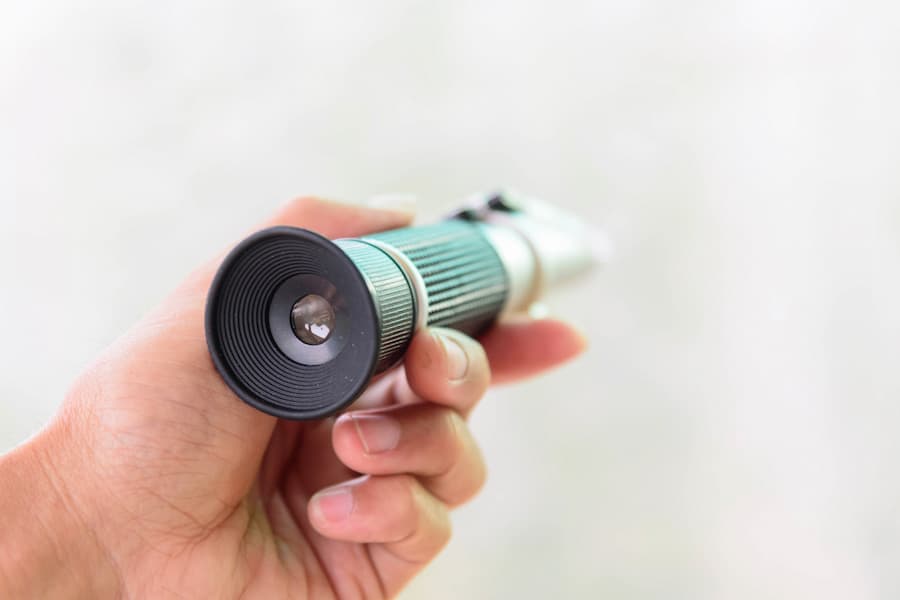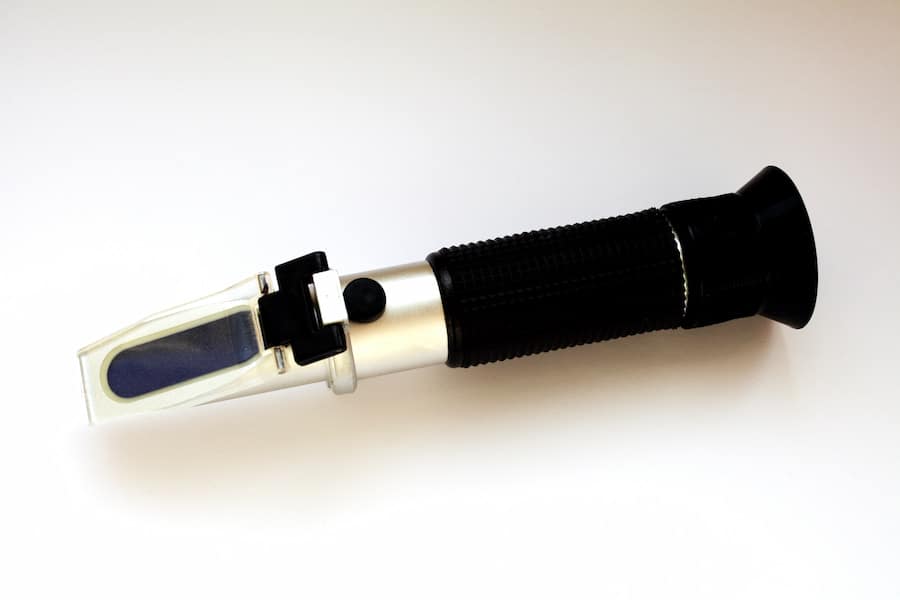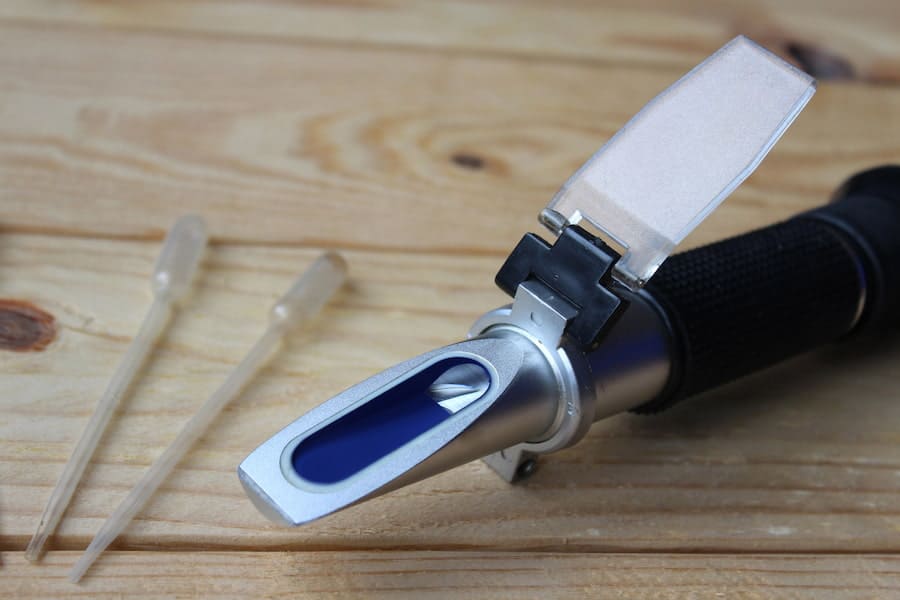If you buy something through a link in our posts, we may get a small share of the sale.
A refractometer is a piece of equipment that brewers use to measure the actual gravity of the beer. Gravity is the content of fermentable sugars available for fermentation during a brewing process. If you want to know how to use a refractometer to measure alcohol content, you will need to understand how it works and its calibration.
Contents
How to Use a Refractometer to Measure Alcohol Content
Considering that brewing and the production of alcohol are all about the fermentation of sugars, you can use a refractometer to obtain the sugar content in the fermenting beer. You, in turn, use those readings to calculate the alcohol amount in the beer by following the steps below:

Use Distilled Water to Set Your Refractometer
Usually, refractometers are calibrated during their manufacture, but make sure you look at their calibrations every time you are using them for your readings to be as precise as possible. To do so:
- Open the flap that envelopes the prism.
- Add distilled water to it at least three drops.
- After closing the flap, hold your refractometer towards the light.
- Check whether the settings are right, and adjust the center ring to observe the calibration. Typically, the Brix scale is calibrated in refractometers, whereby a one-degree Brix represents a 1% sucrose by mass.
Ensure the line that cuts through the blue and white sections crosses your calibration at the center/zero mark. If this is not the case, you can use a screwdriver to remove the plastic cap enveloping the screw to fine-tune your refractometer. After satisfied with the refractometer calibrations, place back the cap and proceed.
Using a towel or a piece of cloth, gently wipe the prism. Drying is crucial because if you leave some water on it and then add some drops of beer to it, the water affects the sugar concentration. This dilution might cause a great impact on the measurements.
Take a Few Drops of Wort
With a refractometer, you don’t waste much of your beer as you only require some drops of beer. You can take a small beer sample using a metal spoon, pipette, and wine thief. Before taking a sample, ensure you thoroughly sanitize the instrument. Give it adequate drying time and then put it in the beer.
Poor sanitization of these tools can contaminate the entire batch, so you should be extremely careful.
Add Some Beer On The Clear Glass
Open the flap that envelopes the prism, add some beer and again lock the flap. This step ensures an even spread of the sample on the clear glass of the refractometer.
Place the Refractometer Towards the Lights and Take the Measurements
Holding the refractometer towards the light, check whether the settings are okay, and if need be, use the center ring to fine-tune the focus. Record the readings as you focus on the white and blue parts on the Brix scale.
Calculate the Alcohol Content
After taking the Brix reading, you can convert it to specific gravity using this simple equation.
SG= 1+(0.004 x Brix)
You can convert it to specific gravity in gravity points for easier remembrance by multiplying the Brix reading by 4.
Wash and Wipe the Refractometer
Before putting the refractometer in its housing, ensure you clean and dry the clear glass with a towel or a piece of cloth. Use distilled water to get rid of all the beer remains.

Ways of Improving Accuracy During Readings
The readings of a refractometer vary from the readings of a hydrometer. It is, therefore, important to make some corrections on your refractometer Brix reading for you to get the correct results.
Correct the Brix Reading
A refractometer measures the sucrose content in a solution and displays the reading. However, the wort contains varying sugars such as fructose, glucose, sucrose, and maltose, there is a need for correction. Typically, the refractive indices of these sugars affect the refractometer measurements.
The correction of the reading ensures that your measurements are more of the hydrometer reading. Although most refractometers have a Wort Correction Factor of about 1.004, it varies from one refractometer to the other.
By dividing your Brix reading with this correction, you can determine the actual Brix reading. For instance, if your Brix Reading is 14.6, the correct reading is 14.6/1.004.
Use the Automatic Temperature Compensation
Most brewer’s refractometers come with an automatic temperature compensation feature. The automatic temperature control feature is a function that allows brewers to use a refractometer under ambient temperatures of around 50 degrees Fahrenheit to 86 degrees Fahrenheit.
Again, this should not be an issue if you want to record the gravity reading of boiling beer. Simply allow it to cool below this temperature before the reading. Fortunately, since you are using a small sample, it only takes a few seconds to cool.
If your refractometer does not have the ATC, use the chart included with the refractometer to get the compensated reading. Simply use the air temperature and the reading to get the added or subtracted value to compensate.
Take Several Measurements
When taking measurements using a refractometer, you only use a small sample of beer or wort, so taking several measurements can cause much wastage of your beer. Take at least two or three measurements to get the most precise measurements possible.
Understanding How Refractometers Operate
Refractometers operate using refraction. Refraction refers to the change in the direction of light as it moves from one see-through material to another. If you place a straw in a soda bottle or a bottle of water and view the glass from the top, it appears bent due to refraction.
The way lenses refract light to zoom subjects and put them into sharper focus is another example of refraction. The amount of light refracted relies on the index of refraction of substances it passes through.
When you dissolve sugar in water, its refractive index will increase with the amount of sugar you dissolve. A refractometer has a prism attached in an aluminum body with a scale labeled on it and an eyepiece.
Reading the Refractometer Scale
When the clear glass is dry, the scale has a pale grayish blue color. When you place some water on the clear glass, the light getting in the refractometer is refracted, making the bottom of the Brix scale turn white.
A refractometer scale is calibrated in Brix units, equal to the percentage of sucrose you dissolve in water. You can calibrate the refractometer, so when you place distilled water on the clear glass, the boundary in the middle of the white and blue areas divides the scale into two at zero Brix.
The boundary connecting the white and blue areas also comes together with varying points on the Brix scale. The scale position changes depending on the fermentable sugars you dissolve in water.
Adjusting the Brix Reading
Refractometers accurately measure the percentage of sugar in unfermented wort. When fermentation begins, the alcohol produced affects the reading, and the Brix reading will require adjustments.
Using the best yeast for alcohol changes the fermentable sugars in the beer into alcohol during fermentation. It means the sugar amount in the final brew is less than the initial one before fermentation. When calculating the percentage ABV of beer, you are only required to obtain the fermentable sugars in your beer before yeast addition, and the amount of sugar after fermentation is complete.
Enter the values in a calculator to find out if you need to increase the ABV of your brew. Usually, calculators have a Wort Correction Factor. If you are unaware of your refractometer’s correction factor, you can leave it as its impact on the computation is minimal.
Types of Refractometers for Homebrewing
Refractometers ideal for home brewing is known as Brix meters or saccharometers. The scale calibrations are in Brix and sometimes a second scale calibrated in specific gravity.
You can still use other refractometers, such as the automatic temperature compensation. Typically, these refractometers do not require you to wait for your beer to cool down to take your measurements.
Although the general principle is still the same, the accuracy of the measurement depends on the refractometer you are using. Also, some are easier to use than others.

Handheld Analog Refractometer
A handheld analog refractometer uses lenses and prisms to cast a shadow line on a piece of glass that shows a shadow line on the equipment. While holding the device to the sun, you can Check via the magnifying eyepiece to read the measurement results.
It is best to use it to calculate the Brix value of beer, soft drinks, industrial liquids, and coolants. Many handheld refractometers have a water resistance rating which simplifies the cleanup procedure and enhances durability.
Digital Refractometer
The way a digital refractometer works is equivalent to an analog refractometer. The main difference between these refractometers is the light source. Typically, a digital refractometer uses light from an LED, while the analog refractometer uses daylight.
A digital refractometer provides a better resolution and has a wider scale producing a far more precise reading. It has automatic temperature compensation, which calculates the current temperature in the final result.
How to Maintain Refractometers
A refractometer is a simple tool but requires maintenance to provide accurate readings. Here is how to prolong its durability and enhance accuracy in readings:
- Store the refractometer in a dry place
- Keep the equipment at a consistent temperature, not going above 112 Fahrenheit or below 14 Fahrenheit
- Avoid using more than three drops of a sample
- Avoid immersing the refractometer or holding it under a stream of fluid
- Considering that cleaning helps in preventing cross-contamination, ensure you clean the measuring surface after every use
- Dry the instrument thoroughly after every use
- Ensure you handle it with care
Frequently Asked Questions
Which Light Source Does a Refractometer Use?
The standard light source for refractometers is the yellow light from a sodium vapor lamp. However, they can also use LED light sources, CCD sensors, and prisms. The digital multi-wavelength refractometers allow the taking of measurements at varying wavelengths.
Is a Refractometer Temperature-Dependent?
A refractometer reading and refractive index are temperature dependent. An increase in temperature decreases the refractive index. It is important to note the temperature when you take the refractive index measurements.
Does Temperature Affect the Brix Reading?
The Brix measurement changes depending on temperature. The Brix of a hot sample will measure lower than that of a cold sample.
Can a Refractometer Go Bad?
A refractometer can break or go out of calibration like any other device. If you notice that its results are unreliable, you need to buy a new one or fix it. Avoid banging it as this does not fix the problem but is a way of breaking it.
Final Thoughts
Learning how to use a refractometer to measure alcohol content will help you determine the ABV in your beer and take your brewing to the next level. Keep in mind that a refractometer helps you measure the sugar content, from which you can calculate the alcohol content.

